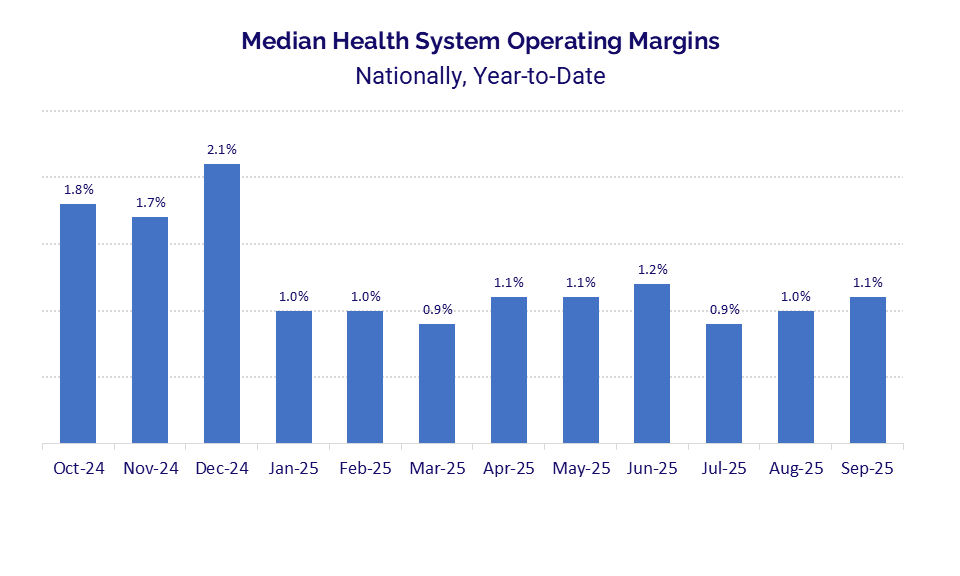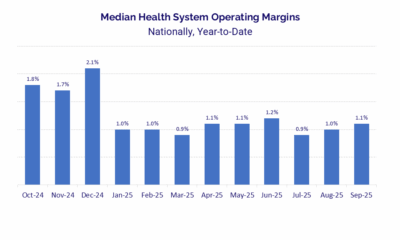Health
U.S. Hospitals Grapple with 1.1% Margin as Expenses Surge

U.S. healthcare organizations are facing significant financial challenges, with operating margins remaining critically low at just 1.1% as of September 2025. This persistent strain is attributed to escalating expenses that outpace revenue growth, according to the latest analysis from Strata Decision Technology.
Expense Pressures Intensify
Despite a steady increase in gross revenue, hospitals are experiencing deepening financial pressure, primarily due to surging non-labor expenses. The report highlights a staggering 12.8% year-over-year increase in drug expenses, alongside a 12.1% rise in supply costs from September 2024 to September 2025. These increases collectively pushed total non-labor expenses up by 9.3% year-over-year, significantly outpacing the 5.0% increase in labor costs. Overall, total hospital expenses rose by 7.5% year-over-year, culminating in challenging financial conditions as the third quarter closed.
Regional disparities are evident, with hospitals in the Midwest suffering the highest year-over-year increase in drug expenses at 17.3%, followed closely by the West at 15.7%. “Operating margins have faltered throughout the first three quarters of 2025 as healthcare organizations feel the full weight of rising expenses,” stated Steve Wasson, Chief Data and Intelligence Officer at Strata Decision Technology. He emphasized the need for organizations to manage expenses diligently to maintain performance amidst these economic pressures.
Growth in Outpatient Revenue
While expenses continue to climb, there has been a notable shift in patient care patterns towards outpatient services, contributing to an increase in gross revenue. Nationally, outpatient visits surged by 9.8% year-over-year in September, with the South and Midwest leading this growth. Inpatient admissions also saw a rise, increasing by 5.3%, while emergency visits experienced a slight decline of 0.5%.
Gross operating revenue reflected these trends, climbing by 11.4% year-over-year. This growth was driven by a 12.8% increase in outpatient revenue and a 9.8% rise in inpatient revenue, showcasing a resilient demand for healthcare services despite the overarching financial challenges.
Additionally, physician practices are beginning to see signs of relief in 2025. The median investment required to support these practices decreased for the first time, falling to $311,264 per physician full-time equivalent (FTE) in the third quarter, a decrease of 4.7% from the prior quarter and 1.8% from the same quarter in the previous year. While median total expenses per physician FTE remain high at around $1.1 million, they did show a slight decrease of 1.3% compared to the second quarter of 2025.
The insights presented in this report utilize data from Strata’s StrataSphere® database and Comparative Analytics, incorporating data from over 650 hospitals and 135,000 physicians, which represents approximately 25% of all provider spending in U.S. healthcare. The findings underscore the pressing need for healthcare organizations to adapt to evolving economic circumstances while striving to maintain operational viability.
-

 Technology4 months ago
Technology4 months agoDiscover the Top 10 Calorie Counting Apps of 2025
-

 Health2 months ago
Health2 months agoBella Hadid Shares Health Update After Treatment for Lyme Disease
-

 Health3 months ago
Health3 months agoErin Bates Shares Recovery Update Following Sepsis Complications
-

 Technology4 weeks ago
Technology4 weeks agoDiscover 2025’s Top GPUs for Exceptional 4K Gaming Performance
-

 Technology2 months ago
Technology2 months agoElectric Moto Influencer Surronster Arrested in Tijuana
-

 Technology4 months ago
Technology4 months agoDiscover How to Reverse Image Search Using ChatGPT Effortlessly
-

 Technology4 months ago
Technology4 months agoMeta Initiates $60B AI Data Center Expansion, Starting in Ohio
-

 Technology4 months ago
Technology4 months agoRecovering a Suspended TikTok Account: A Step-by-Step Guide
-

 Health4 months ago
Health4 months agoTested: Rab Firewall Mountain Jacket Survives Harsh Conditions
-

 Lifestyle4 months ago
Lifestyle4 months agoBelton Family Reunites After Daughter Survives Hill Country Floods
-

 Technology3 months ago
Technology3 months agoUncovering the Top Five Most Challenging Motorcycles to Ride
-

 Technology4 months ago
Technology4 months agoHarmonic Launches AI Chatbot App to Transform Mathematical Reasoning




















